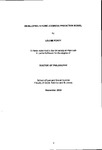DEVELOPING A HOMELESSNESS PREDICTION MODEL
| dc.contributor.author | Forty, Louise | |
| dc.contributor.other | Plymouth Business School | |
| dc.contributor.other | Faculty of Arts, Humanities and Business | en_US |
| dc.date.accessioned | 2013-09-24T10:41:38Z | |
| dc.date.available | 2013-09-24T10:41:38Z | |
| dc.date.issued | 2008 | |
| dc.identifier | NOT AVAILABLE | en_US |
| dc.identifier.uri | http://hdl.handle.net/10026.1/1921 | |
| dc.description | Merged with duplicate record 10026.1/1307 on 13.20.2017 by CS (TIS) | |
| dc.description.abstract |
The purpose of this research was to produce a model to predict levels of homelessness within a local authority area. The research considered data on a wide range of issues embedded in theory and supported by the literature as being common precedents to homelessness. Areas of investigation included housing, migration, poverty, deinstitutionalisation. ethnicity, poor health, drug abuse, sex and age, relationship breakdown as well as general variables profiling the area. Data was compared both to the numbers of homeless decisions made within a local authority area as well as the numbers of those decisions that resulted in the full homeless duty being accepted. Multiple regression techniques and factor analysis were used to determine the issues most strongly correlated with levels of homeless decisions and therefore useful for the production of a prediction model. Models were produced for different types of council (e.g. borough councils, district councils, city councils etc) using different variables. A number of independent variables were identified as being reliable predictors for numbers of homeless decisions for two to three years into the future. These variables were the number of people experiencing limiting long-term illness; the number of people separated but not divorced; the number of under 18 conceptions; the number of people in receipt of income based job seekers allowance and the number of people of mixed race. In addition to these individual issues, a 'social disadvantage factor' combining all of these issues generally proved to be the most accurate and reliable variable for use in a regression model for predicting numbers of homeless decisions. Previous research in this area has been predominantly qualitative in nature. This study provides a new step towards a useable quantitative tool for prediction purposes. The models provide a level of objectivity to prediction and therefore have important implications for local government policy. | en_US |
| dc.language.iso | en | en_US |
| dc.publisher | University of Plymouth | en_US |
| dc.title | DEVELOPING A HOMELESSNESS PREDICTION MODEL | en_US |
| dc.type | Thesis | |
| plymouth.version | Full version | en_US |
| dc.identifier.doi | http://dx.doi.org/10.24382/3404 | |
| dc.identifier.doi | http://dx.doi.org/10.24382/3404 |
Files in this item
This item appears in the following Collection(s)
-
01 Research Theses Main Collection
Research Theses Main


